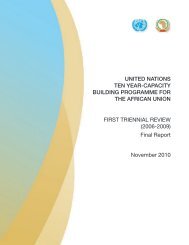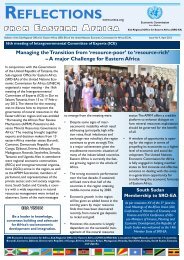Tool kit for Gender and Agriculture - Economic Commission for Africa
Tool kit for Gender and Agriculture - Economic Commission for Africa
Tool kit for Gender and Agriculture - Economic Commission for Africa
You also want an ePaper? Increase the reach of your titles
YUMPU automatically turns print PDFs into web optimized ePapers that Google loves.
10<br />
<strong>Gender</strong> in <strong>Agriculture</strong><br />
higher effective costs <strong>for</strong> in<strong>for</strong>mation, technology, inputs, <strong>and</strong> credit <strong>and</strong> their productivity<br />
is lowered. Women also lack incentives to increase productivity: food crop prices<br />
are low, their access to markets is poor, <strong>and</strong> husb<strong>and</strong>s often control the income from<br />
the products of women’s labor.<br />
C. Why <strong>Gender</strong> Makes a Difference<br />
Women are, of course, an integral part of farming households. They produce over half<br />
the food in many developing countries, bear most responsibility <strong>for</strong> household food<br />
security, <strong>and</strong> contribute to household well-being through their income-generating activities.<br />
Yet, women usually have more limited access to resources <strong>and</strong> opportunities<br />
<strong>and</strong> their productivity remains low relative to their potential. In some regions, men <strong>and</strong><br />
women have different farming systems, different domains⎯<strong>for</strong> example, crops or<br />
livestock⎯different access to resources, <strong>and</strong> different status. In general, compared to<br />
men within the same household, women have:<br />
• A wider range of tasks <strong>and</strong> enterprises<br />
• Different production objectives<br />
• Dissimilar production constraints.<br />
Econometric evidence on gender differences in agricultural productivity points<br />
to the importance of investing in women by increasing their human capital through<br />
education <strong>and</strong> extension, <strong>and</strong> by increasing their access to physical <strong>and</strong> financial inputs.<br />
Key findings are:<br />
• Women farmers are as efficient as men farmers, once other characteristics <strong>and</strong><br />
input levels are controlled <strong>for</strong>. 1<br />
Simulations using Kenyan data (see Table 1)<br />
suggest that increasing women’s physical <strong>and</strong> human resource capital to the<br />
level of men’s would bring significant gains in agricultural production. Limited<br />
access to inputs combined with cultural constraints on women’s farmwork tend<br />
to reduce women’s labor productivity <strong>and</strong> their participation in highproductivity<br />
agricultural work. 2<br />
• Women farmers underper<strong>for</strong>m in agricultural production because they lack access<br />
to in<strong>for</strong>mation, credit, extension, inputs, <strong>and</strong> markets <strong>and</strong> by household <strong>and</strong><br />
child care tasks limit the time they have available. This underper<strong>for</strong>mance oc-<br />
1 A. Quisumbing, 1994, <strong>Gender</strong> Differences in Agricultural Productivity: A Survey of Empirical Evidence,<br />
Discussion Paper Series No. 36, Education <strong>and</strong> Social Policy Department, World Bank,<br />
Washington, D.C.<br />
2 A. Quisumbing (1994).







